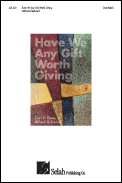|
Composer Alfred V. Fedak
Text Carl P. Daw, Jr.
Voicing SATB, kybd.
Topics Christian Life, Praise and Adoration, Renewal
Scripture reference Romans 12:1-2
Lectionary usage Proper 16A
Price $2.25 (U.S.)
Length 2' 35" Released 6/15
Catalog no. 410-320
Difficulty Mod. easy
|
Order now!
Order PDF download!
Min. of 5
Anthem text
Have we any gift worth gi
ving
to the Giver of all things?
What would please the ever-living
one true God from whom life springs?
Not dead gold or merchandise,
but a living sacrifice:
worship both profound and freeing, serving God with all our being.
Christ by costly incarnation
dwelt in human time and place
to reveal to all creation
God's redeeming love and grace:
so are we in flesh and bone
given means of making known
through the web of daily living
God's own pattern of self-giving.
Let us shun the selfish merit
worldly wisdom has defined,
but renewed by God's own Spirit
be transformed in heart and mind:
by past mercies taught and led,
let us seek the path ahead,
trusting that, like those before us,
God will guide us and restore us.
Carl P. Daw, Jr.
Words © 1995 Hope Publishing Company, Carol Stream, IL 60188. All rights reserved. Used by permission. www.hopepublishing.com
|
|
 
Description This joyous anthem sparkles with delight. Carl P. Daw’s text based on Romans 12:1-2 celebrates God’s ultimate gift to us. Alfred V. Fedak’s effervescent music alternates duple and triple rhythms throughout in a natural and text-driven way. Sure to become a choir favorite.
Review
"Two recent hymn texts receive conventional, yet not simplistic, settings by Alfred Fedak. .... Have We Any Gift Worth Giving is Carl Daw’s poetic rumination on Romans 12 and the call to be a living sacrifice. Fedak’s tune alternates measures in compound and simple meter, creating a jaunty, sprightly character. The structure of the three verses again resides well within compositional norms of the genre, yet no single hymn tune melody governs the piece. The middle verse begins with a repeat of the melody but moves in different directions. The last verse is entirely in 4/4 time with contours similar to the melody as heard previously, but now moving in more stately fashion. The variegation in melody prevents this from being a concertato, and accordingly, no provision for congregational participation is included. As a pure choral anthem, however, the nod toward the hymn tune format is an attractive quality that makes the piece feel familiar even on first hearing." --AAM Journal
|






























